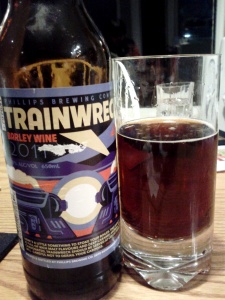A seasonal by Phillips brewery, this 10% barley wine packs a punch. For those unfamiliar, a barley wine has nothing to do with wine, except that it has a strong alcohol percentage — likening the percentage of wine. It is still, of course, fermented from grain — barley — rather than grapes, and, though many other styles of beer, such as a Russian Imperial Stout, may boast a high alcohol percentage, barley wines are a distinctly unique class of ale. They tend to be complex, earthy, fruity, a touch sour — winelike — and malty.
– Kamran
*****
I must admit, despite my current familiarity and experience with complex beers, such as barley wines and lambics, the Trainwreck, tasted about a half of a year ago, broke my barley wine cherry. Because of this, my initial impression of the beer was certainly flawed. I have since seen the err of my ways. The complexity of a barley wine surprised me, and I gave the beer extra credit simply for its uniqueness. Fact is, it’s really not unique, and after trying several other barley wines, the initially strong impression once held in my mind — of the Trainwreck — faded away.
The nose has a slight florality that is masked by delicate hops, lots of complex malts, and a slightly sour, wine-like — reminds me of a 1989 Chateaux Musar I once tasted — aroma. It’s quite heavy, and, therefore, a sipping beer; however, you couldn’t tell it was 10%. I certainly couldn’t drink more than one bomber bottle, though. Like with other complex beers, familiarity causes the flavours to grow on you, and I found myself enjoying it more as I continued drinking it. I think it was better warm, too. That said, the flavours are quite subtle, and nothing jumps out at you. In all its complexity, the flavours are muddled together, sending rather incoherent sensations on the palate. This results in what I find the weakest aspect of the beer: the finish. It lingers in an awkward, bitter-sour way. Still, a relatively enjoyable beer overall.
Nose: 20.5
Body: 20
Taste: 18.5
Finish: 17.5
Kamran: 76.5 pts.
*****
Now when it comes to barley wine I’m the first to admit, probably not a beer choice you’ll want to session all night long unless you find one that blows you away, and while the Phillips Trainwreck isn’t exactly one I’d recommend for a night session it does grow on you to the point where one or two of the 750ml bottles are a nice way to spend an evening with company. Certainly a beer that improves as you drink it, whether it be to the increase in flavours as it warms slowly or that your palate adjusts, this brew is likely my favourite of the two Phillips barley wines we’ve tried.
On the nose it has all the tell-tale signs of barley wine in regards to sweetness with faint hops, and the body is fairly typical as well. The beer is savoury, smooth, and heavier compared to most barley wines, but certainly no liquid meal like some people find with stouts. The flavour is caramel tones, with a slight hops tucked away. The finish is smooth with a slight bitterness/tang after you swallow it, with a lingering sweetness that you’d expect.
While I’ve certainly had better barley wines I could see myself ordering this at a pub or getting another bottle at the store for a night’s one-off beer. Not a wow-factor contender overall though, but the scoring is reflective on something above average at least.
Nose: 20.5
Body: 22
Taste: 19
Finish: 18.5
Tristan: 80 pts.
*****
Final Average: 78.25 pts.




